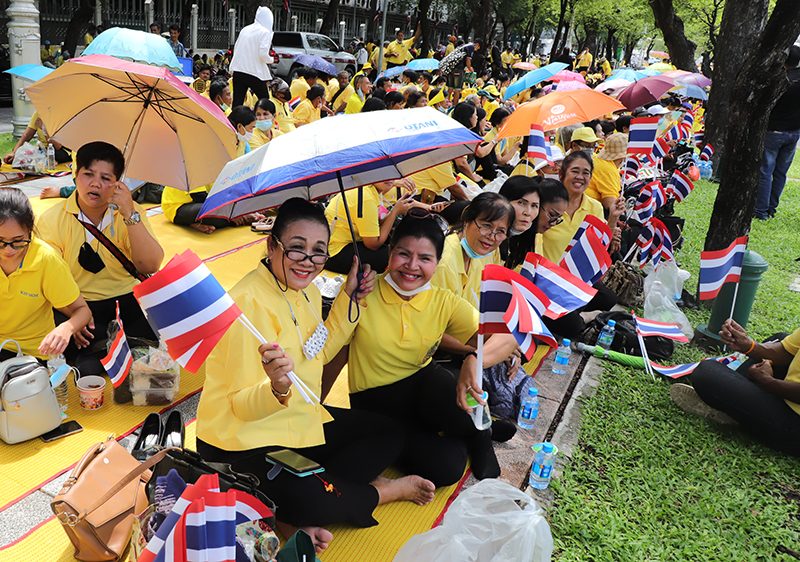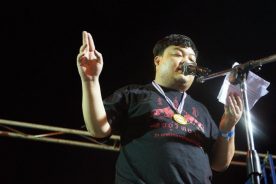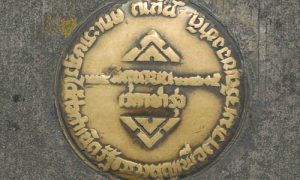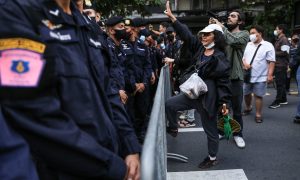If observers thought student-led protests and international support would genteelly bring the authoritarian leadership in Thailand to its knees and the monarch to the negotiating table, they are at this point of time most mistaken. Propaganda dominates, as seen in the junta-derived government encouraging yellow-shirt reactionaries to also take to the streets, including soldiers (wearing yellow shirts), cadets, regime-appointed subdistrict officials, village heads and public sector servants. These new developments are dangerous. We have seen pro-democracy groups take their grievances to the streets in the past, only to have agents provocateurs and royalist reactionaries mobilised to generate confrontation and violence. This is the endgame in an authoritarian state-sanctioned ruse.
The regime’s propaganda machinery is at full steam to reignite social division, mocking the student-led protestors as anti-monarchists. The root of Thailand’s intractable social division goes back to the disgruntled, bankrupted media tycoon Sondhi Limthongkul more than fifteen years ago. Sondhi was “tasked” by royalists and motivated by a personal vendetta to bring down the former elected prime minister Thaksin Shinawatra. We ought not to forget that the mobilisation of yellow-shirt street protests led to the 2006 coup, whose pretext was described by junta leader General Sonthi Boonyaratglin as “to restore normalcy and to create unity” in the wake of a prime minister who was accused by those who themselves engendered social division of “creating a rift in society” and (without grounds) “repeatedly insulting the king.”
The current situation may well lead to violent confrontation, making military intervention appear once again necessary and justified. But the social and organisational schismatics of counter-protest are complicated by the diehard royalist yellow shirt factions, such as former PDRC followers, who are not necessarily sympathetic to the current ruling status quo but instead more aligned with divergent royalist interests and loyalties (such as to the king’s sister Sirindhorn).
The student-led protests, increasingly involving a broad social base, also have a genealogy that stretches back to the red-shirt protests of 2009-10. Many of these students on the frontline were too young to know the violence and injustices committed on pro-democracy protestors during 2010, but seem to be well informed through alternative free media and their better-informed seniors. Gratitude and recognition to the red-shirt demands more than a decade ago were given on stage by one of the protest leaders Parit “Penguin” Chirawak. (“Penguin” and Thammasat University anthropology student Panusaya “Rung” Sithijirawattanakul were arrested and then released on bail, only to be rearrested in relation to previous sets of charges. This could keep them tied up in court procedures for months.)
At the time of the 2010 massacre of unarmed protestors, there was considerable reluctance by the international media (as well as skewed domestic media coverage) to talk about the legitimacy of the red shirt claims, or to expose the atrocities committed on the streets in Bangkok. The persecution over the past decade has not stopped. In contrast, we see live coverage of the student-led protests beamed across the world in real time (with even multi-lingual coverage).
There were a few attempts over the past week to engender violence as seen in an attack on a student by yellow shirts that was ignored by the police at Ramkhamhaeng University. However, to date students have shown maturity and calm in handling provocations. Despite Prayut futilely trying to portray the student-led protestors as a violent mob and committing “terrible crimes…against the police”, there have been no media reports which mention any such attacks.
At this time, the regime, under international attention as it resorted to unleashing chemically laced water on 16 October, can only deploy the police. It may also call in to service its royalist judiciary, always ready to create trumped up charges such as Article 110 of “harming the queen’s liberty” against ideological leaders Ekkachai Hongkangwan, Boonkueanoon Paothong and Suranat Paenprasoet after the bizarre royal motorcade incident on 14 October. As media videos showed, the protestors were nowhere close to impairing the royal motorcade. (Where was the king at the time?)
The ten demands that shook Thailand
Behind the student protests for reforms to the monarchy that are shaking the century-old foundations of Thailand's political system.
The latter demand does not imply “toppling” the monarchy (ผังล้มเจ้า), though semantics make little difference to die-hard ultra-royalists concerned about the risks of democratic reforms to their network or patronage privileges. For many military-royalist elites including Palang Pracharath puppet politicians, there is also a fear of accountability should a democratic government and a just rule of law be applied in Thailand. These emplaced political and judicial decision-makers have a lot to lose. The criminal court, under royal influence but perhaps now somewhat fearful of increasing international attention, overturned an order by the regime to shut down media broadcasting of the protests.
At this point, the student-led protests have the numbers. But if they are to succeed in their demands, the students need to capture an even broader mass support to make any difference to the current status quo.
Their second demand in regard to the constitution is also important. A constitution is supposedly a mechanism for the organisation, distribution and regulation of power. Although a foundational law of the state, its origins are always extra-legal and construct a normative framework for the organisation of the state and its multiple institutions. The current 2017 hashed military constitution of Thailand is not a “people’s constitution” (รัฐธรรมนูญของประชาชน). Instead it is a partisan constitution which allows for the capture of (absolute) state power by a monarchy-military (“deep state”) alliance. As a “juristocracy”, the regime prospers on misuses and abuses of what is termed “judicial review.”
In a democratic society, given social and cultural changes, a constitution will always need revisions to reflect the concerns and cultural values of its citizens in accordance with the rule of law. A constitution should allow for a reimagining of a nation’s history and society, and remain open to new possibilities that consider anew the nature of the social and the political in Thailand. The students who are protesting are doing just this and arguing that now is the time for change. But while it seems that the ruling regime hears, it does not (want to) listen (พวกเขาได้ยินแต่พวกเขาไม่ฟัง).
 Facebook
Facebook  Twitter
Twitter  Soundcloud
Soundcloud  Youtube
Youtube  Rss
Rss 



